Daniel Mulino must withdraw his minority report
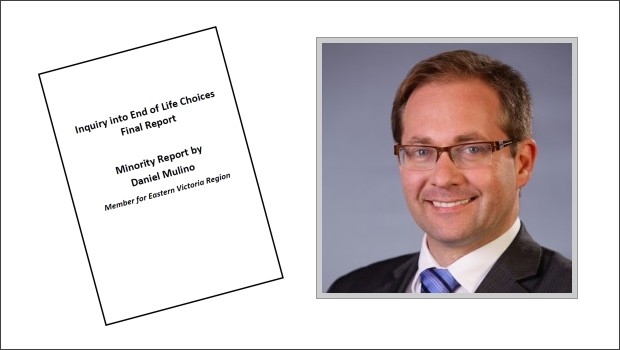
Last year, the Victorian Parliament's Legal and Social Issues Committee concluded an extensive investigation into end of life choices, publishing a report of over 400 pages recommending improvements to palliative care and for assisted dying. Catholic-backed Shop, Distributive and Allied Employees' Association (‘shoppies’ union) Labor member of the Victorian Parliament Mr Daniel Mulino furnished his own minority report, opposing the majority recommendation for assisted dying law reform. That’s entirely his right. However, his report contains multiple, serious cases of misinformation. He must withdraw his report.
Daniel Mulino, Labor parliamentary member for the Victorian Region of Eastern Victoria,1 and a member of the Catholic-backed ‘shoppies’ union,2 was a member of the Legal and Social Issues Committee that thoroughly investigated end of life decision making and produced a 400+ page report in 2016 making recommendations for law reform and regulation.
Mr Mulino furnished a “minority report” as an addendum to the main report in order to oppose the Committee’s recommendation that assisted dying be legalised.3
Promoted by Catholics to Catholics
Mr Paul Russell, South Australian publisher of the Catholic anti-euthanasia website ‘HOPE,’§ says this of Mr Mulino’s minority report in the Catholic lawyer association’s blog:4
“Daniel Mulino MLC's analysis should be read first, before the Majority Report. It forms not only a sound academic and rigorous approach but also, by implication, is damning of the narrow, outcome focus of the Majority Report.”
How sweet of Mr Russell to so generously plug Mr Mulino’s report. But, in gushing about the ‘sound academic and rigorous approach’ he claims to be in it, shows that he doesn't understand what constitutes proper and sound evidence, and that he's easily impressed by charts and lots of ‘literature’ citations.
Numerous fundamental faults
The reality is very different.
Rather than bore you with a mind-numbing blow-by-blow dissertation on the numerous fundamental faults in Mr Mulino’s report, I’ll demonstrate how the report cherry-picks, misquotes and misunderstands its way through the evidence, via four revealing examples.
Example 1. Cherry-picking ‘helpful’ data
Mr Mulino’s minority report illustrates the rise in number of assisted deaths in the Netherlands and Belgium, and produces some statistics (Figures 1 & 2 are directly from his minority report).
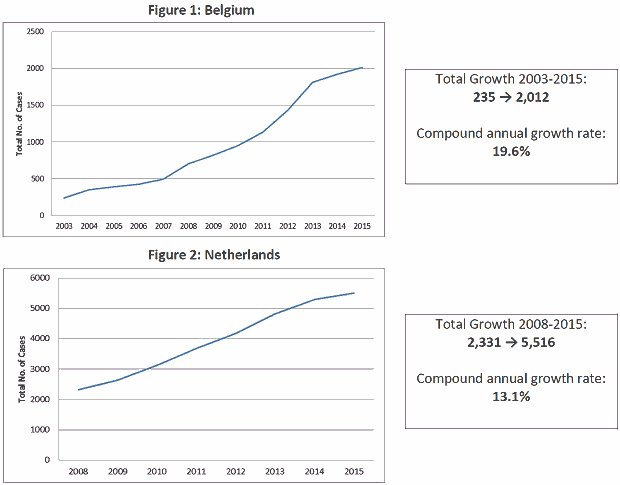 Figures 1 and 2 (of Mr Mulino’s minority report): Assisted deaths in Belgium and the Netherlands
Figures 1 and 2 (of Mr Mulino’s minority report): Assisted deaths in Belgium and the Netherlands
Note that Belgian data is for the years 2003–15, but the Netherlands only for the years 2008–15. That’s odd, because the euthanasia Acts for both countries came into effect in 2002, and so 2003 was the first full year for both.
Mr Mulino doesn’t point out that his report treats the two countries differentially, and provides no explanation as to why. We might notice, however, that the dicrepancy has the consequence of making his claims look 'better.'
Using Mr Mulino’s presentation style, Figure 3 illustrates all the relevant data for the Netherlands.
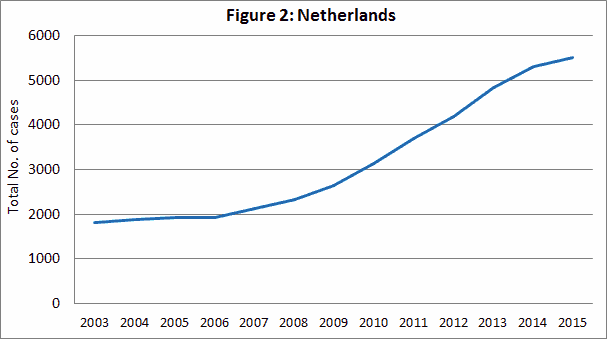 Figure 3: The full Netherlands data
Figure 3: The full Netherlands data
Source: Official Euthanasia Commission reports
As you can see, there is a virtual flatline between 2003 and 2007. Indeed, there is even a tiny drop in numbers between 2005–06. This is an inconvenient truth to Mr Mulino’s thesis that there has been a consistent massive rise in numbers. It also substantially reduces the compound annual growth rate he wrongly quotes for just 2008–15.
He’s also cherry-picked only raw data. In fact, the only valid way to compare year to year, and jurisdiction to jurisdiction, is to use the rate for each year: that is, the number of assisted deaths as a proportion of total deaths in the same year and jurisdiction, so that you’re comparing apples with apples. It's necessary because the total deaths count goes down and (mostly) up a bit each year. The official government statistics for total deaths by year for both countries are readily available online, so there’s no excuse for not using them.
When you calculate the rates, you get validly-comparable results, as I illustrate in Figure 4.
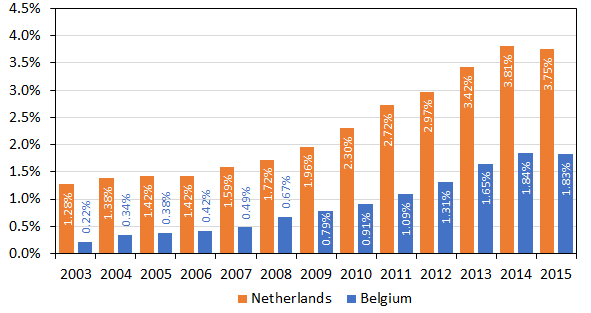 Figure 4: Rate of assisted dying as a percent off all deaths in the Netherlands and Belgium 2003–2015
Figure 4: Rate of assisted dying as a percent off all deaths in the Netherlands and Belgium 2003–2015
Sources: Official government statistics; Euthanasia Commission reports
As I explain in my detailed research whitepaper on Benelux assisted dying,5 these are sigmoid (stretched-S) shaped curves which are typical of human behaviour change. And there is a drop in the rate in both countries in 2015, which Mr Mulino doesn’t report.
My Benelux whitepaper also reports the data from Luxembourg (Figure 5), which Mr Mulino fails to mention, even though it has legislation, since 2009, almost identical to the Netherlands and Belgium, and the Luxembourg government's data is freely available online.
 Figure 5: Rate of assisted dying in the three lawful Benelux countries
Figure 5: Rate of assisted dying in the three lawful Benelux countries
Sources: Official government statistics; Euthanasia Commission reports
Luxembourg’s data (yellow in Figure 5; no data available yet for 2015), is also an inconvenient truth to the case Mr Mulino attempts to prosecute. There’s no substantial rise.
Example 2. Comparing apples with oranges: mis-matching data
Mr Mulino again fails to compare apples with apples. Take, for example, his vocal claim that the annual total death counts for the Netherlands decreased at the same time as the total counts for assisted dying increased.
When you look at the data he’s used (the citation for the negative total deaths trend he quotes in his Table 2), you find that he’s used total death data for 2000–10, which is falling, while his assisted dying data is for 2008–15, which is rising.
This just isn’t on: it’s completely invalid to compare data like this from one period with data from another period to claim or imply a causal relationship. Of what possible relevance is the total death data for 2000–02, while his total deaths data for 2011–15 is missing? I illustrate the full story in Figure 6.
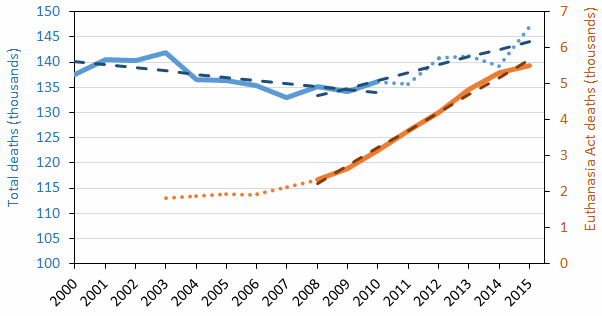 Figure 6: Netherlands total and assisted deaths for different periods
Figure 6: Netherlands total and assisted deaths for different periods
Sources: Official government statistics; Euthanasia Commission reports
The solid blue and orange lines are data Mr Mulino used and reported, and their dotted ends are data that he omitted. It’s easy to see that the total deaths data his report inappropriately relies upon has a negative (downwards) slope (left-hand blue dashes), while the matching total deaths data he should have used has a positive (upwards) slope (right-hand blue dashes). Valid comparison gives lie to his claim.
Example 3. White is the new black: Misquoting the opposite
Mr Mulino’s report also argues that there’s ample evidence that a significant proportion of people with depression are gaining access to assisted dying:
“Ganzini et al, in a broad ranging review of instances of assisted dying in Oregon, found that twenty percent of the patients had symptoms of depression.” [Italics mine]
This assertion is nonchalantly plucked from the review6 without reading it properly, seemingly to support his thesis. In fact, the source does the exact opposite. Figure 7 is an image of the Abstract, where it says in large print, right up front:
“Twenty percent of the patients had symptoms of depression; none of these patients received a prescription for a lethal medication.” [Emphasis is mine]
 Figure 7: The paper Abstract articulates exactly the opposite of Mr Mulino’s claim
Figure 7: The paper Abstract articulates exactly the opposite of Mr Mulino’s claim
Source: Ganzini et al 20006
Had Mr Mulino bothered to read either the abstract or the methodology of this study properly, he would have realised that the doctor sample was of those eligible to prescribe under Oregon’s Death With Dignity Act, not just those who had, and that none of the study's patients who were assessed with possible depression had accessed an assisted death.
It's not like the information was hard to find — his report cites literally half a sentence to support his claim, when the full sentence says the opposite.
Example 4. Any port in a storm: Cherry-picking, misunderstanding and misrepresenting out-of-date data
In attempting to establish a 'slippery slope' from voluntary, to non-voluntary euthanasia (NVE) — a practice where doctors may hasten death (e.g. by administering increasing doses of opioids) when the patient hasn’t explicitly requested it — Mr Mulino states in his minority report:
“Two countries with the highest rates of this type of end-of-life (Belgium at 1.5% and the Netherlands at 0.60%) allowed the practice of euthanasia and assisted dying.”
Oh dear, Mr Mulino's report cherry-picks again. Just look at his source.7 The study, published in 2003, contains Table 2, with the relevant data in it (Figure 8).
 Figure 8: Table 2 from the 2003 study Mr Mulino cites
Figure 8: Table 2 from the 2003 study Mr Mulino cites
Source: van der Heide et al 20037
There are no fewer than five major offences Mr Mulino commits here.
Firstly, look at the table. I’ve highlighted the line in yellow from which Mr Mulino draws his figures of 1.5% for Belgium and 0.60% for the Netherlands. You can immediately and easily see that Denmark’s rate of 0.67% is higher than the Netherlands' of 0.60%.
So, Mr Mulino’s statement mentioning only Belgium and the Netherlands with “highest NVE rates” is misleading. He failed to either report or explain why Denmark’s rate is higher than the Netherlands, while Denmark doesn’t have an assisted dying law; the opposite of his thesis.
Secondly, he also fails to mention Switzerland’s NVE rate of 0.42%, or to explain that it’s lower than the Netherlands and Belgium. That’s highly relevant, because Switzerland has the world’s oldest assisted dying law — in effect since 1942 — and its statute contains none of the safeguards in the Belgian and Dutch Acts. This too is at odds with Mr Mulino’s thesis.
Thirdly, if Mr Mulino had read the study properly instead of just cherry-picking convenient figures from it, he would have noticed in the methodology section that the fieldwork (doctors filling in questionnaires) was completed in 2001 and early 2002, that is, before either the Netherlands or Belgian Acts came into effect later in 2002 (the Netherlands in April and Belgium in September).
Thus, the Dutch and Belgian data points Mr Mulino advances as ‘evidence’ of an NVE ‘slippery slope’ from legislated assisted dying have nothing whatever to do with assisted deaths under their Euthanasia Acts, because neither Act existed at the time the study was conducted.
Fourthly, he is resorting here to a single point-in-time study, which has little to no scientific power to establish ‘causation’. To really establish causation, as a minimum you have to assess longitudinal data, which I show in Figure 9. It demonstrates the precise opposite of Mr Mulino's ‘slippery slope’ thesis that voluntary euthanasia causes NVE, which if true would lead to a significant increase in the NVE rate in both countries after statutory legalisation.
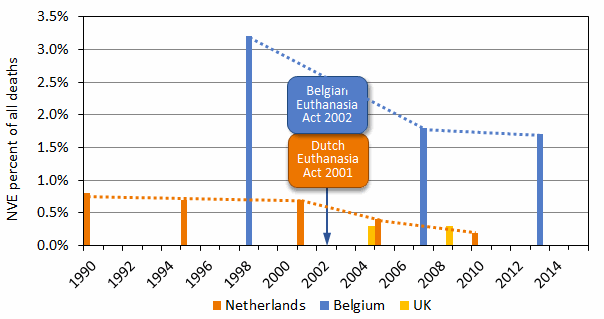 Figure 9: Longitudinal NVE rates in the Netherlands, Belgium and the UK
Figure 9: Longitudinal NVE rates in the Netherlands, Belgium and the UK
Sources: Netherlands8; Belgium9; UK10
Both the Dutch and Belgian NVE rates have dropped with high statistical significance since their euthanasia Acts came into effect. Indeed, the NVE rate in the Netherlands is now similar to the rate in the UK, which is acknowledged as the world’s gold standard in palliative care and which has never had an assisted dying law. This is consistent with assisted dying law reform shining a bright light on all end of life practices.
It’s not like he simply didn’t know
Fifthly, it’s particularly disappointing that Mr Mulino’s report only cherry-picked outdated data in an attempt to ‘prove’ his case when I had already directly furnished the current relevant evidence to his Committee as a properly-researched formal submission: Figure 9 above is Figure 19 in my submission, and I provided the peer-reviewed research citations for the data.11
Not only that, but the official transcript of my appearance as an expert witness before the parliamentary Committee confirms that Mr Mulino specifically quizzed me on that Figure 19 and I pointed out the sources of its data:12
“Mr MULINO — Figure 19, for example.
Mr FRANCIS — The reference should be in the text. The last sentence on the previous page gives you the citations for that data.
Mr MULINO — Okay.”
Even further, when fellow-Committee-member and Catholic assisted dying opponent Mrs Inga Peulich asked about the same thing (with Mr Mulino present) — “1,000 of those who have been accidentally euthanased in the Netherlands” — I literally put the chart up on the projection screen and explained it in full to the Committee until they had no more questions. The “1000” figure is the approximate rate prior to the Dutch Euthanasia Act, while the rate has dropped significantly since.
The evidence is irrefutable: it’s not like Mr Mulino was merely blissfully unaware of the relevant data contradicting his NVE ‘slippery slope’ claim. His minority report expressly overlooks this robust evidence and instead refers inapproriately to selective and outdated data that seemed to, but didn’t, support his argument.
Five major offences in a single citation: surely Mr Mulino’s report — far from ‘academic and rigorous’ — sets a new record?
A common religious thread?
The NVE ‘slippery slope’ claim is also popular amongst and spread by the Catholic Archdioceses of Melbourne,13 Sydney14 and Brisbane,15 as well as by other Catholic anti-assisted dying lobbyists such as Alex Schadenberg,16 Paul Russell,17 and Professor of Ethics at the Catholic University of Notre Dame Australia, Margaret Somerville.18
Indeed, Mr Mulino’s minority report appears amongst 11 Catholic responses against assisted dying law reform published by the Catholic Archdiocese of Melbourne (Figure 10).
 Figure 10: Daniel Mulino’s minority report appears amongst Catholic responses on the Catholic Archdiocese of Melbourne’s website19
Figure 10: Daniel Mulino’s minority report appears amongst Catholic responses on the Catholic Archdiocese of Melbourne’s website19
Indeed, Mr Mulino’s linked document doesn’t seem to emanate from his parliamentary office or from wider parliamentary services: the PDF file's metadata reveals that it was authored, electronically at least, by “mmacdonald”.
Calls to both Mr Mulino's electorate office and to the Parliament of Victoria confirm there is no "M Macdonald" at either. I did, however, find online one Matthew Macdonald, researcher and Executive Officer of the Catholic Archdiocese of Melbourne’s (CAM) Office for Life, Marriage and Family — in other words, the same organisation that published the list in Figure 10 containing the link to Mr Mulino’s minority report.
Mr Macdonald is also listed as the CAM's official contact person in its submission (#705) opposing assisted dying to the Victorian Parliament's inquiry into end of life choices.20 Both the CAM and Mulino reports also refer to a journal paper by Catholic doctor José Pereira,21 and neither report mentions the subsequent evidential rebuttal outlining why Pereira's claims were merely "smoke and mirrors".22 Even more curiously, the Pereira paper is included in Mr Merlino's minority report bibliography, though his report doesn't actually cite it as the CAM submission does.
The CAM parliamentary submission was authorised and signed by Episcopal Vicars Anthony Ireland and Anthony Kerin, who also appeared as witnesses before the parliamentary Committee, during which they told, as I've explained, a whopping great falsehood about Oregon.23
Conclusion
Contrary to Paul Russell’s enthusiastic claim that Daniel Mulino’s minority report provides a ‘rigorous’ case against assisted dying law reform, the report merely serves as further evidence of how those implacably opposed to assisted dying can cherry-pick, misunderstand and rather desperately clutch their way through their ‘evidence.’
Mr Russell is not an academic expert and one can understand his limited capacity to judge whether work is ‘scholarly.’ However, Mr Mulino holds a PhD in economics from Yale,* so it’s quite astonishing that he published a ‘researched’ report containing multiple major flaws, including outdated and cherry-picked data contrary to more recent, direct and relevant evidence of which he was specifically aware, actively inquired into and had explained and cited to him in full.
These anomolies beg the question: did Matthew McDonald or someone else at the Catholic Archdiocese of Melbourne write Mr Mulino’s report for him? Mr Mulino needs to explain himself, since regardless of who authoried it, he signed it off in his own name and is therefore ultimately responsible for it.
Given the multiple fundamental errors, the honourable course for Mr Mulino to pursue is to withdraw his minority report.
The question is: will he rise to the occasion?
Addendum: A missed opportunity for primary research
Mr Mulino — as well as Mrs Peulich who also wrote a minority report against assisted dying — declined to join other members of the parliamentary Committee on an official overseas fact-finding tour to jurisdictions where assisted dying is lawful. This was a critical opportunity for Committee members to directly quiz proponents, opponents, researchers, regulators, legislators and others with direct experience. It would have given them invaluable opportunities to directly examine and test assumptions, hypotheses and performance. How curious then that these two non-participataing Committee members each furnished a minority report opposing the majority recommendation to legalise assisted dying in Victoria.
---------------
§ The HOPE website is an initiative of the Australian Family Association (AFA), a faith-based organisation founded by Australia’s most famous Catholic, B. A. Santamaria. Mr Russell is a former Vice President of the AFA, and a former Senior Officer for Family and Life at the Catholic Archdiocese of Adelaide.
* While Mr Mulino holds a PhD and would be entitled to be addressed as “Dr”, his Parliamentary title is “Mr”.
References
- Parliament of Victoria 2017, Daniel Mulino, viewed 20 Mar 2017, https://www.parliament.vic.gov.au/members/details/1764-daniel-mulino.
- Tomazin, F 2016, Explainer: The push towards a dying-with-dignity policy in Victoria, Fairfax Media, viewed 3 Dec 2016, https://www.theage.com.au/national/victoria/explainer-the-push-towards-a-dyingwithdignity-policy-in-victoria-20161203-gt3bso.html.
- Legal and Social Issues Committee 2016, Inquiry into end of life choices. Final report, Parliament of Victoria, Melbourne, pp. 444.
- Russell, P 2016, End-of-life choices report: A sugar coated poison pill for Victoria, Melbourne Catholic Lawyers Association, viewed 14 Jun 2016, https://www.catholiclawyers.com.au/latest-news/853-end-of-life-choices-report-a-sugar-coated-poison-pill-for-victoria.
- Francis, N 2016, Assisted dying practice in Benelux: Whitepaper 1, DyingForChoice.com, viewed 13 Nov 2016, /resources/fact-files/assisted-dying-benelux-whitepaper-1.
- Ganzini, L, Nelson, HD, Schmidt, TA, Kraemer, DF, Delorit, MA & Lee, MA 2000, 'Physicians' experiences with the Oregon Death with Dignity Act', New England Journal of Medicine, 342(8), pp. 557-563.
- van der Heide, A, Deliens, L, Faisst, K, Nilstun, T, Norup, M, Paci, E, van der Wal, G & van der Maas, PJ 2003, 'End-of-life decision-making in six European countries: descriptive study', The Lancet, 362(9381), pp. 345-350.
- Onwuteaka-Philipsen, BD, Brinkman-Stoppelenburg, A, Penning, C, de Jong-Krul, GJF, van Delden, JJM & van der Heide, A 2012, 'Trends in end-of-life practices before and after the enactment of the euthanasia law in the Netherlands from 1990 to 2010: a repeated cross-sectional survey', The Lancet, 380(9845), pp. 908-915.
- Bilsen, J, Cohen, J, Chambaere, K, Pousset, G, Onwuteaka-Philipsen, BD, Mortier, F & Deliens, L 2009, 'Medical end-of-life practices under the euthanasia law in Belgium', New England Journal of Medicine, 361(11), pp. 1119-1121.
- Seale, C 2009, 'End-of-life decisions in the UK involving medical practitioners', Palliat Med, 23(3), pp. 198-204.
- Francis, N 2015, Submission to the Parliament of Victoria Standing Committee on Legal and Social Issues on the Inquiry into End of Life Choices, DyingForChoice.com, Melbourne, pp. 51.
- Parliament of Victoria 2015, Standing Committee on Legal and Social Issues inquiry into end-of-life choices: Witness-Mr Neil Francis, DyingForChoice.com, Melbourne, pp. 10.
- The Catholic Leader 2010, No to euthanasia – Yes to genuine care, Catholic Archdiocese of Brisbane, viewed 15 Dec 2010, https://catholicleader.com.au/features/no-to-euthanasia-yes-to-genuine-care_70380/.
- Catholic Archdiocese of Sydney 2017, Experts warn against following overseas experience with euthanasia, viewed 12 Mar 2017, https://www.catholicweekly.com.au/2017/2017120_1449.shtml.
- Catholic Archdiocese of Brisbane 2010, No to euthanasia - yes to genuine care, The Catholic Leader, viewed 25 Feb 2012, https://catholicleader.com.au/features/no-to-euthanasia-yes-to-genuine-care_70380/.
- Schadenberg, A 2013, Exposing vulnerable people to euthanasia and assisted suicide, Ross Lattner, London ON.
- Russell, P 2015, Submission 926: Submission to the Victorian Legal and Social Issues Committee inquiry into end of life choices, HOPE, Melbourne, pp. 56.
- Francis, N 2017, Margaret Somerville misleading claim - 'Non-voluntary euthanasia slippery slope', DyingForChoice.com, viewed 19 Apr 2017, /resources/videos/margaret-somerville-misleading-claim-non-voluntary-euthanasia-slippery-slope.
- Catholic Archdiocese of Melbourne 2017, Why now in Victoria?, viewed 3 Aug 2017, https://www.cam1.org.au/euthanasia/Be-Informed/Why-now-in-Victoria.
- Catholic Archdiocese of Melbourne 2015, Submission to the Legal & Social Issues Committee: Inquiry into end of life choices, Submission 705, Melbourne, pp. 16.
- Pereira, J 2011, 'Legalizing euthanasia or assisted suicide: the illusion of safeguards and controls', Current Oncology, vol. 18, no. 2, pp. e38-48.
- Downie, J, Chambaere, K & Bernheim, JL 2012, 'Pereira's attack on legalizing euthanasia or assisted suicide: smoke and mirrors', Current Oncology, vol. 19, no. 3, Jun, pp. 133-8.
- Francis, N 2015, Catholic Church misinforms Parliamentary inquiry, DyingForChoice.com, viewed 25 Nov 2015, http://www.dyingforchoice.com/blogs/catholic-church-misinforms-parliamentary-inquiry.
